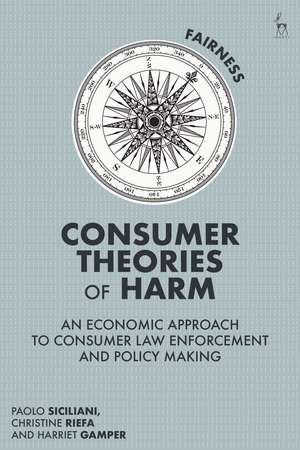Consumer Theories of Harm: An Economic Approach to Consumer Law Enforcement and Policy Making
Autor Paolo Siciliani, Christine Riefa, Harriet Gamperen Limba Engleză Hardback – 18 sep 2019
| Toate formatele și edițiile | Preț | Express |
|---|---|---|
| Paperback (1) | 263.92 lei 6-8 săpt. | |
| Bloomsbury Publishing – 7 apr 2021 | 263.92 lei 6-8 săpt. | |
| Hardback (1) | 540.80 lei 6-8 săpt. | |
| Bloomsbury Publishing – 18 sep 2019 | 540.80 lei 6-8 săpt. |
Preț: 540.80 lei
Preț vechi: 774.26 lei
-30% Nou
Puncte Express: 811
Preț estimativ în valută:
103.51€ • 106.67$ • 87.39£
103.51€ • 106.67$ • 87.39£
Carte tipărită la comandă
Livrare economică 01-15 martie
Preluare comenzi: 021 569.72.76
Specificații
ISBN-13: 9781509916856
ISBN-10: 1509916857
Pagini: 248
Dimensiuni: 156 x 234 mm
Greutate: 0.57 kg
Editura: Bloomsbury Publishing
Colecția Hart Publishing
Locul publicării:London, United Kingdom
ISBN-10: 1509916857
Pagini: 248
Dimensiuni: 156 x 234 mm
Greutate: 0.57 kg
Editura: Bloomsbury Publishing
Colecția Hart Publishing
Locul publicării:London, United Kingdom
Caracteristici
Develops an intuitive framework to map concrete cases against the various theoretical settings, providing practitioners with the required clarity as to how allegations of consumer law breaches can cause consumer detriment
Notă biografică
Paolo Siciliani is a Visiting Lecturer in Law & Economics at UCL LawsChristine Riefa is a Reader in Consumer Law at Brunel University.Harriet Gamper is a Consumer Policy practitioner.
Cuprins
1. IntroductionI. The Search for Fairness II. Origins of Theories of Harm in Competition Law III. Using Theories of Harm in Consumer Law - A Natural Evolution IV. Harnessing the Use of Economics in Consumer Law V. Contents 2. The Limitations of Consumer Law in Tackling Consumer Harm I. Introduction II. Limitations in the Use of Information as a Mainstream Transparency Approach III. Limitations of the Definition of the 'Average Consumer' Used as a Reference Point for Protection IV. Implementation of the 'Average Consumer' Standard under the Unfair Commercial Practices Legislation V. Protecting 'Vulnerable' and 'Disengaged' Consumers VI. Limitations Found in Unfair Terms Legislation VII. The Enforcement Framework in the UK 3. The Limitations of Competition Law in Tackling Consumer Harm I. Introduction II. Ex-Post Enforcement against Exploitative Abuses III. The Case for a Holistic Approach under an Ex Ante Administrative Market Regime IV. The Enforcement Framework in the UK 4. The Economic Framework Underpinning Consumer Theories of Harm I. Introduction II. Consumer Surplus III. The Economic Case for Intervention in Consumer Markets IV. Concluding Remarks 5. Archetypal Consumer Theories of Harm I. Introduction II. The Scam III. The Lemon IV. The Shock V. The Subsidy VI. Concluding Remarks 6. Applying CToHs - Case Studies I. Case Study on the CMA Market Inquiry into Retail Energy II. Case Study on Bank Current Accounts and Savings AccountsIII. Case Study on Claims for Compensation in the Airline Industry IV. Case Study on Allocated Airline Seating V. Case Study on Fertility Add-Ons 7. Fairness by Design: The Introduction of a Positive Duty to Trade FairlyI. Introduction II. Justifications for Adopting a More Prescriptive Standard of Conduct for the Protection of Consumers III. Introducing a Positive Duty to Trade Fairly IV. The Impact of a General and Positive Duty to Trade Fairly V. Conclusion
Recenzii
Worthy reading for anyone interested in consumer law and policy . The authors have asked all the right questions, and have made important steps towards finding the right answers.
